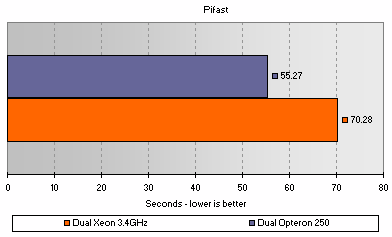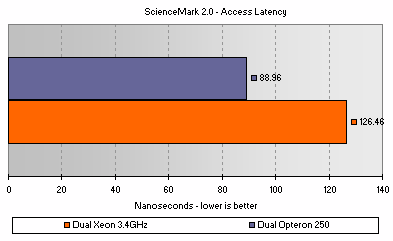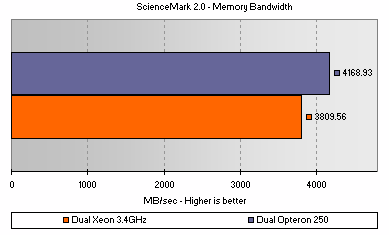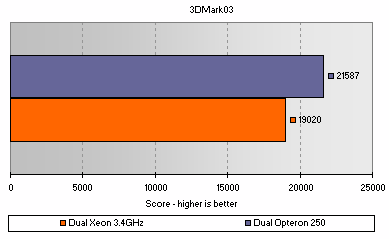Memory Tests and 3DMark 2001SE
Our usual memory subsystem tests give us a basic idea that everything is working correctly, on the CPU side of things too.HEXUS Pifast

Pifast is single-threaded and so gains nothing from having the second CPU present in each test system. The Opteron 250 is acting like a single Athlon FX-53 processor on Socket 940, with the 3.4 Xeon acting like a new 3.4F Pentium 4 on LGA775.
The onboard memory controller is the big win for Opteron here, with Pifast enjoying the lower access latency on that system. A strong FPU also helps and Prescott's beefed up basic functional units lets the Xeon do decently, but it's no match for the very strong basic AMD64 architecture in Opteron form.
ScienceMark 2.0 - Access Latency

Opteron's memory controller shines here, with the MCH-based controller in the Xeon system way slower when the CPU needs to access main memory outside of its caches. It's something we've seen time and time again with regular Athlon 64 and Pentium 4, and with these 'workstation' CPUs being based on the same 'desktop' cores, we see it again here.
ScienceMark 2.0 - Memory Bandwidth

With roughly 5400MB/sec available to each CPU on the Opteron system, 77% efficiency is what we've come to expect. The Xeon system musters 60% efficiency from the Tumwater MCH, nearly exactly what's measured on a comparable Prescott system with the same DDR-II configuration.
Overall, the memory subsystems on each system are working as expected. One thing to note is while Windows 2003 Enterprise is NUMA-aware, and the mainboard should program the SRAT, ScienceMark 2.0 doesn't access the SRAT and measure memory bandwidth across all NUMA nodes (the CPUs in the system in this case), so you get a figure from a single CPU.
3DMark 2001SE
Just for giggles, I ran 3DMark 2001SE on each system, initially just on the Tumwater system so I could get a handle on its PCI Express performance, compared to an i925X system I'd setup using 2GB of memory, a 6800 GT and a 3.4 Prescott. It puts up numbers that are very similar, so it looks like Tumwater's PCI Express controller, at least for PEG, is essentially what you'll find on Alderwood. That's not to say that the interface had any real influence over 3DMark 2001SE's performance, but it's nice to see that you don't get worse performance on Tumwater, should you look to do a little gaming on your Xeon workhorse when it's not churning out 3DS Max frames.
The Opteron is simply a stronger gaming CPU.
Onwards to the rest of the benchmarks, now we know things are working properly.









